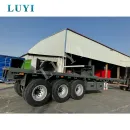Semi-trucks are the backbone of the transportation industry, hauling goods across vast distances. But did you know that there are various types of semi-trucks, each designed for specific purposes? Understanding the different types of semi-trucks can help you appreciate the complexity and efficiency of modern logistics.
Cab Types
The most basic distinction between semi-trucks lies in their cabs.
Day Cab: A day cab is the most common type, designed for shorter hauls and local deliveries. As the name suggests, it's not equipped with a sleeper berth for overnight stays.
Sleeper Cab: For long-haul trips, sleeper cabs are essential. They provide a sleeping compartment for drivers to rest during their journeys. Sleeper cabs come in various sizes, from small to large, depending on the driver's comfort and the length of the haul.
Specialized Semi-Trucks
Beyond the basic cab types, semi-trucks can be further categorized based on their specialized applications:
Tankers: These trucks are equipped with large tanks to transport liquids such as gasoline, chemicals, and food products.
Refrigerated Trucks: Also known as reefers, these trucks are used to transport temperature-sensitive goods like perishable food and pharmaceuticals.
Flatbeds: Flatbed trucks have a flat platform for hauling oversized or irregularly shaped cargo.
Dump Trucks: These trucks are used for hauling and dumping materials such as gravel, sand, and construction debris.
Additional resources:4 Advice to Choose a Hydraulic Modular Trailer ManufacturerWhat's The Best Semi Truck Brand? That Depends…Sliding Axle and Hydraulic Tail TrailersHow to Select Five-Axis Low Bed Trailer for Heavy Machinery?How to Choose a 7-Axis Module Low Bed Drag Plate?What Benefits Does a 7-Axis Module Low Bed Drag Plate Offer?10 Things You Need to Understand about Howo 60 Ton Crane Trailers Featuring Quick Couplers
Lowboy Trucks: With their low-profile decks, lowboy trucks are designed to transport heavy equipment and oversized loads.
Factors Influencing Semi-Truck Selection
The choice of semi-truck depends on several factors:
Cargo type: The nature of the cargo determines the type of trailer and special equipment required.
Distance: Long-haul trips typically require sleeper cabs for driver comfort.
Regulations: Different regions have specific regulations regarding truck dimensions and weight limits.
Fuel efficiency: Fuel economy is a critical factor, especially for long-haul operations.
The Role of Technology
Modern semi-trucks are equipped with advanced technology to enhance safety and efficiency. Features like electronic stability control, lane departure warning, and automatic braking systems are becoming increasingly common. Additionally, telematics systems help track vehicle location, fuel consumption, and maintenance needs.
Understanding the different types of semi-trucks is crucial for anyone involved in the transportation industry. Whether you're a fleet manager, a driver, or simply a curious observer, this knowledge will help you appreciate the complexity and sophistication of these massive vehicles and the vital role they play in our economy.
Additional resources:How Does the Latest Electric Car Charging Station Technology Work?The Advantages of Utilizing 850mm Lowbed for Heavy Equipment TransportUnlocking Efficiency: 850mm Lowbed for Heavy Vehicle Transport2024 Guide to Pull-Out Low Bed Carriage for Crane TransportationPull-Out Low Bed vs Traditional Carriage: Transporting Cranes EfficientlyMaximize Efficiency with 3 Axle Low Flat Semi for Equipment TransportHow Does a 5 Axle High-Roof Trailer for Long-Distance Hauling Work?





Comments
All Comments ( 0 )